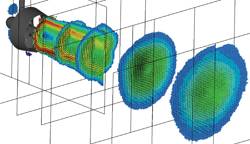New Initiatives Probe Thruster Interaction Effects
MARIN has a long history in research into the performance of thrusters during Dynamic Positioning (DP) operations. Research on ducted propellers started in the late 1960s (Oosterveld) but a lot of today’s knowledge on thruster interaction effects was developed in the late 1980s and early 1990s (Nienhuis).
As a result of the application of DP systems on many different vessels, there is continued interest in this subject. Today, newly developed tools enable more detailed measurements and computer simulations of the thrusters on DP vessels. This has lead to new research initiatives to improve the understanding of thruster interaction effects.
During DP operations the effective force generated by thrusters can be significantly smaller than would be expected based on the thrusters’ open water characteristics. This is a result of thruster interaction with the hull, current and the wake of neighbouring thrusters. The understanding and quantification of thruster interaction (or thrust degradation) effects is essential for an accurate evaluation of the station-keeping capabilities of DP vessels.
At present, thrust degradation effects can be quantified using data available from literature,or by carrying out dedicated model tests. Published data can give valuable insights but often it is too general, or not applicable to the specific design. Model tests, on the other hand, do provide detailed results but they are relatively expensive. In addition, model test results often only become available relatively late in the design process, making it difficult to incorporate the results in the design.
CFD calculations could be an alternative method but there is little experience in the application of CFD as an engineering tool for thrust degradation effects. With the rapidly increasing capabilities of CFD models and computer hardware, the time is right for the development of new tools to analyse thruster interaction.
New measuring techniques
In the summer of 2009, MARIN received its new stereo-PIV measurement system which has a powerful Class 4 laser with two digital cameras built into a single underwater housing (see Report 98). A research project was carried out to evaluate the possibilities of using the PIV system for measuring the flow velocities in the wake of an azimuthing thruster. Model tests were carried out in MARIN’s Deepwater Towing Tank. An example of the measured wake velocities in open water conditions, showing both cross sections and velocities in the longitudinal plane, is shown above.
Results show that the new PIV system is capable of recording the velocity field in the propeller wake, with a level of detail that was not possible before. This data is extremely valuable for the validation of CFD calculations. The model test programme also included measurements with the thruster built into a barge model. Here, the deflection of the thruster wake, due to the presence of the hull and its rounded bilge (Coanda effect), could be captured (see example alongside). These first PIV measurements will be used as validation material for CFD calculations. A key issue in these calculations is the correct representation of the shape of the thruster wake.
Research efforts
In the coming years, CFD calculations will increasingly be used as an engineering tool for application in offshore hydrodynamics. Examples are the calculation of current and wind loads, viscous effects in wave loads, VIM and the analysis of thruster interaction. MARIN’s research plans for CFD have been documented in a “roadmap”, in a bid to streamline R&D.
Currently, MARIN is starting a Joint Industry Project on the hydrodynamics of thruster interaction, called the Thrust Hydrodynamics JIP (TRUST JIP). The TRUST JIP aims to gain insight into physical phenomena, quantifying thruster interaction effects and investigating possibilities for improvement. In the TRUST JIP model test data, CFD calculations and full-scale measurements will be combined to provide the methods and tools for the hydrodynamic optimisation of a DP vessel’s thruster configuration during the design.
The project deliverables will include a calculation tool for DP capability calculations. This combines traditional DP capability plots with the evaluation of other operational criteria, such as motions and accelerations. Thruster interaction data obtained will be included in this tool. Guidelines will also be developed on how to use model tests and CFD calculations in the analysis of thruster interaction effects and for the optimization of thruster configurations on DP vessels. More information can be found at http://www.marin.nl/web/JIPs-Networks/Public/ TRUST.htm.
Calculation possibilities
The application of CFD calculations for the analysis of thruster interaction is still largely unexplored. At this moment CFD calculations of a vessel hull, complete with all its thrusters, may seem too complex but suitable modeling methods will be investigated and developed in the near future. A thorough validation of CFD models against measurement results, both at model-scale and at full-scale, is required. An example of some initial calculations on a single thruster under a schematical barge is shown. Results show the same trends found in the measurements by Nienhuis but further developments are necessary to achieve more accuracy.
Research into CFD calculations for thruster interaction will first focus on the calculation of the velocities in the wake of a thruster in open water. The accurate calculation of the velocities, especially at larger distances from the thruster, is crucial for an accurate prediction of thruster interaction effects later on. Different modelling options will be investigated. Subsequently, increasingly complex configurations are considered, introducing step-by-step additional physics, such as friction forces on the hull, deflection of the thruster wake (Coanda effect), the effects of current and loads on appendages. Another example is the calculation of the loads caused by the thruster wake on the opposite pontoon of a semi-submersible. In this manner, the performance of thrusters in various different configurations can be investigated.
The latest developments in CFD calculations and PIV measuring techniques offer new possibilities to increase the understanding of the physics of thruster interaction effects. The TRUST JIP will investigate the applicability, accuracy and limitations of CFD for thruster interaction by comparing the results from model tests, CFD calculations and full-scale measurements.


















